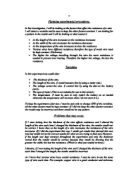Preliminary experiment:
40cm Voltage = 0.06v
Amps = 0.09A
Resistance = 0.06÷0.09
Resistance = 0.67Ω (rounded up to 2 D.p.)
90cm voltage = 0.15
Amps = 0.08
Resistance = 0.06÷0.08
Resistance = 1.88(rounded up to 2 D.p.)
This has now given me a range of lengths to do between 40cm to 90cm of wire
Method (continued): I then decide to do lengths of 40, 50, 60, 70, 80 and 90cm. I drew a table and took readings for the volts and the amps of each length three times, worked out the resistance of each reading to get three separate resistances. Then I worked out an average resistance, a range and a half range. After filling out the table I drew a graph and worked out an equation.
Results:
Conclusion: In conclusion, I have found that as the length of the wire increases, the voltage also increases however the amps decrease. Nonetheless, the voltage increase is sufficient for the resistance to increase as the length increases. In my investigation I also found that resistance is equal to 0.0225 multiplied by the length of the wire, minus 0.22.
Evaluation: One way to improve my experiment is to make it more accurate, I could achieve this by repeating the experiment more times than I did. I would do this because it would help make the error bars smaller, make my results more reliable and help to eradicate anomalies.
In my experiment all but one of the lengths that I did contained no error bars, and the one that did, had a very small error bar. This could imply that my results were accurate, so I am convinced that my conclusion is accurate. The last two points did not go on the line of best fit however all of the others did. To make my results even more accurate I could get more high quality equipment, for example, the voltmeter and ammeter that I used only gave readings to two decimal points, so I could get voltmeters and ammeters that give results to more decimal points. Furthermore, I could repeat this experiment with a new set of apparatus (except for the wire) each time to make sure that there wasn’t any faulty equipment.







